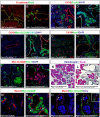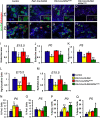Primary cilia regulate Gli/Hedgehog activation in pancreas
- PMID: 20479231
- PMCID: PMC2890485
- DOI: 10.1073/pnas.0909900107
Primary cilia regulate Gli/Hedgehog activation in pancreas
Abstract
Previous studies have suggested that defects in pancreatic epithelium caused by activation of the Hedgehog (Hh) signaling pathway are secondary to changes in the differentiation state of the surrounding mesenchyme. However, recent results describe a role of the pathway in pancreatic epithelium, both during development and in adult tissue during neoplastic transformation. To determine the consequences of epithelial Hh activation during pancreas development, we employed a transgenic mouse model in which an activated version of GLI2, a transcriptional mediator of the pathway, is overexpressed specifically in the pancreatic epithelium. Surprisingly, efficient Hh activation was not observed in these transgenic mice, indicating the presence of physiological mechanisms within pancreas epithelium that prevent full Hh activation. Additional studies revealed that primary cilia regulate the level of Hh activation, and that ablation of these cellular organelles is sufficient to cause significant up-regulation of the Hh pathway in pancreata of mice overexpressing GLI2. As a consequence of overt Hh activation, we observe profound morphological changes in both the exocrine and endocrine pancreas. Increased Hh activity also induced the expansion of an undifferentiated cell population expressing progenitor markers. Thus, our findings suggest that Hh signaling plays a critical role in regulating pancreatic epithelial plasticity.
Conflict of interest statement
The authors declare no conflict of interest.
Figures




Similar articles
-
Elevated Hedgehog/Gli signaling causes beta-cell dedifferentiation in mice.Proc Natl Acad Sci U S A. 2011 Oct 11;108(41):17010-5. doi: 10.1073/pnas.1105404108. Epub 2011 Oct 3. Proc Natl Acad Sci U S A. 2011. PMID: 21969560 Free PMC article.
-
The intrahepatic signalling niche of hedgehog is defined by primary cilia positive cells during chronic liver injury.J Hepatol. 2014 Jan;60(1):143-51. doi: 10.1016/j.jhep.2013.08.012. Epub 2013 Aug 23. J Hepatol. 2014. PMID: 23978713
-
Kinetics of hedgehog-dependent full-length Gli3 accumulation in primary cilia and subsequent degradation.Mol Cell Biol. 2010 Apr;30(8):1910-22. doi: 10.1128/MCB.01089-09. Epub 2010 Feb 12. Mol Cell Biol. 2010. PMID: 20154143 Free PMC article.
-
Regulatory mechanisms governing GLI proteins in hedgehog signaling.Anat Sci Int. 2025 Mar;100(2):143-154. doi: 10.1007/s12565-024-00814-1. Epub 2024 Nov 22. Anat Sci Int. 2025. PMID: 39576500 Review.
-
Developmental and regenerative paradigms of cilia regulated hedgehog signaling.Semin Cell Dev Biol. 2021 Feb;110:89-103. doi: 10.1016/j.semcdb.2020.05.029. Epub 2020 Jun 12. Semin Cell Dev Biol. 2021. PMID: 32540122 Free PMC article. Review.
Cited by
-
Mixed signals from the cell's antennae: primary cilia in cancer.EMBO Rep. 2018 Nov;19(11):e46589. doi: 10.15252/embr.201846589. Epub 2018 Oct 22. EMBO Rep. 2018. PMID: 30348893 Free PMC article. Review.
-
Inhibition of Hedgehog signaling in the gastrointestinal tract: targeting the cancer microenvironment.Cancer Treat Rev. 2014 Feb;40(1):12-21. doi: 10.1016/j.ctrv.2013.08.003. Epub 2013 Aug 13. Cancer Treat Rev. 2014. PMID: 24007940 Free PMC article. Review.
-
Rediscovering Primary Cilia in Pancreatic Islets.Diabetes Metab J. 2023 Jul;47(4):454-469. doi: 10.4093/dmj.2022.0442. Epub 2023 Apr 28. Diabetes Metab J. 2023. PMID: 37105527 Free PMC article. Review.
-
SHh-Gli1 signaling pathway promotes cell survival by mediating baculoviral IAP repeat-containing 3 (BIRC3) gene in pancreatic cancer cells.Tumour Biol. 2016 Jul;37(7):9943-50. doi: 10.1007/s13277-016-4898-0. Epub 2016 Jan 27. Tumour Biol. 2016. PMID: 26815504
-
Loss of a primary cilium in PDAC.Cell Cycle. 2017 May 3;16(9):817-818. doi: 10.1080/15384101.2017.1304738. Epub 2017 Mar 20. Cell Cycle. 2017. PMID: 28319439 Free PMC article. No abstract available.
References
-
- Apelqvist A, Ahlgren U, Edlund H. Sonic hedgehog directs specialised mesoderm differentiation in the intestine and pancreas. Curr Biol. 1997;7:801–804. - PubMed
-
- Hebrok M, Kim SK, St Jacques B, McMahon AP, Melton DA. Regulation of pancreas development by hedgehog signaling. Development. 2000;127:4905–4913. - PubMed
-
- Kawahira H, et al. Combined activities of hedgehog signaling inhibitors regulate pancreas development. Development. 2003;130:4871–4879. - PubMed
-
- Kawahira H, Scheel DW, Smith SB, German MS, Hebrok M. Hedgehog signaling regulates expansion of pancreatic epithelial cells. Dev Biol. 2005;280:111–121. - PubMed
Publication types
MeSH terms
Substances
Grants and funding
LinkOut - more resources
Full Text Sources
Research Materials

